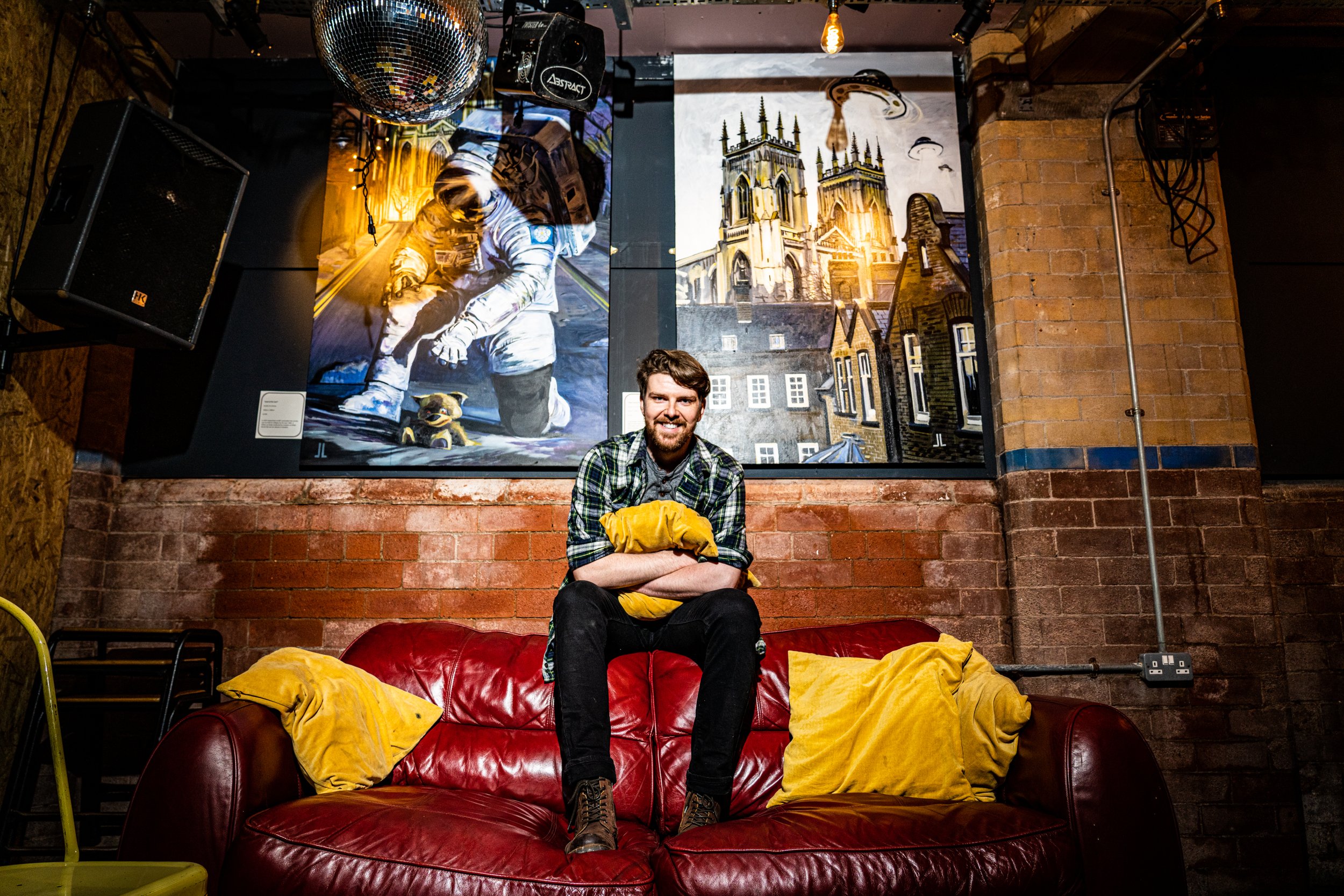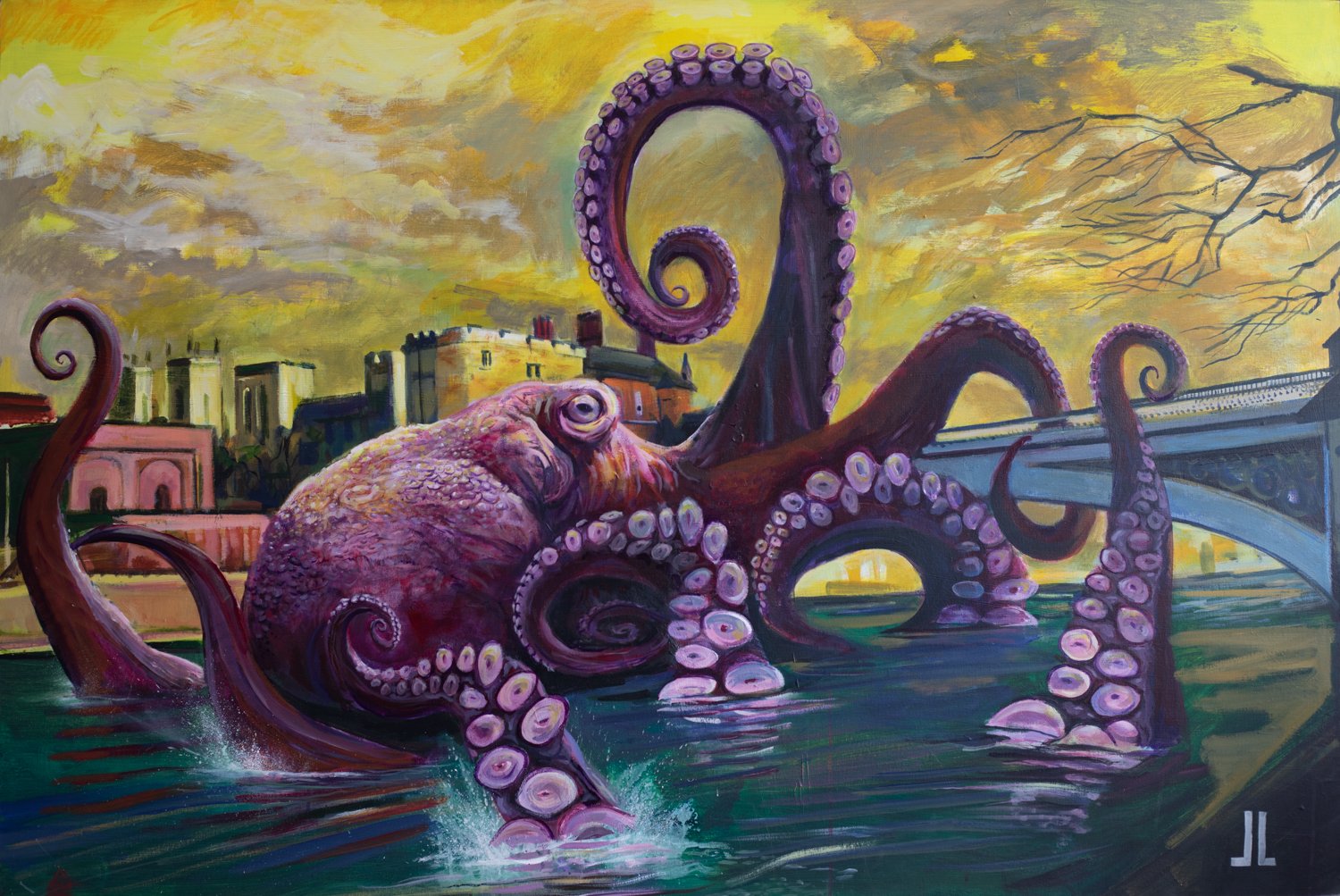ARTIST INTERVIEW: Lincoln Lightfoot
Please can you give me an introduction about yourself.
I am an artist/illustrator that is starting to build up a reputation across North Yorkshire and the North East of England. My artwork explores surreal concepts based in well known locations reminiscent of 1950-60s B-Movie poster art.
What inspired you to paint?
When I was younger I was always fascinated by art. I loved to create and still do. My Dad managed an Art and Design Department at my secondary school in Middlesbrough. This often meant staying late in the Art department with my younger brother creating and developing our GCSE and A-level Fine Art coursework. We’d make fantasy towers and giant killer plants. Exciting topics devised by my father. It was a large Art department with 4 purpose built art classrooms and a vast variety of exciting materials with exotic visual stimuli. There were masks from different cultures, stained glass panels, tapestries, machine bits, musical instruments, giant shells, tropical plants and stuffed animals. No wall was left bare.
Having been perpetually surrounded by awesome art, I have always had the urge to create, whether that is paintings, drawing, sculpting etc… My artwork currently envelops to mediums paint and pen and ink/digital illustration. I relish the painting process (when it is going well) particularly the visceral quality of oil paint.
Describe your creative process; from start to finish of a painting. Where do you find your inspiration?
A lot of my inspiration comes from dramatic B-Movie poster art. During that time, the Cold War kept us in perpetual fear of extinction from nuclear Armageddon until the fall of the Berlin wall and the dissolution of the Soviet bloc. Today we have growing similarities re-emerging due to the conflict in the Ukraine which threatens to spill over into the wider world. Through engagement with Art, we can deal with these nightmares. Children confront and make sense of a dangerous world through stories and rhymes and are taught of danger through the safe spaces of literature and illustration which deal with anecdote and myth. My artwork aims to tap into the present condition of fear that our news media and politicians perpetuate in a post Covid-19 world.
I tend to focus on iconic architecture or a particular location. This typically allows the viewer to already have a relationship with the artwork. I then consider some form of B-Movie type happening. Ideas take the form of sketches and sometimes I collage the imagery using Photoshop. Once I have a perfected pen and ink sketch, I then use it to produce a digital illustration with bold block colour. The ones that are most successful normally become large oil paintings, often starting with an acrylic grisaille under painting.
What is your favourite piece of work and why?
I often get asked this question and the answer tends to be the piece that I’m working on at the time. I’m currently working on a 150x100cm oil on canvas of a tyrannosaurus running down The Shambles. It is currently one of my most successful illustrations. Aesthetically I love how the composition slots together and how the piece is detail rich. While contextually I have taken arguably the most depicted street for its beauty and flipped it on its head.
What do you think makes your work unique?
It’s unique in the sense that I am one of the first to pursue this realm of Pop Art. Contemporary Surrealism addresses peoples worries and stresses and provides an escape into an alternative world and helps us cope with anxiety in safe and sometimes humorous ways in these times of isolation and stress. It differs from the pioneers of the 20’s and 30’s with the advances in film and graphic media. We have the tools to blur reality with fantasy even more convincingly. Freudian Psychology, Giorgio, De Chirico, and Romanticism, originally fed the ideas of the Surrealist movement, but the real spark to the fantasy-world seems to have been the horrors of World War One and born out of Italian Futurism.
What is the purpose/goal of your work?
I hope to produce engaging imagery to poke fun at frightening happenings, to deal with the absurd, to have younger viewers deal with their fears in a humourous way. From the Brothers Grim to Disney movies we are taught to deal with difficult real life scenarios. My disbelief for current world events cushions my conscience. As touched on before I hope that my artwork is a humorous release from the real world. I find it increasingly reminiscent of the creation of Godzilla in 1954. Godzilla being a Hollywood whitewashed Hiroshima metaphor. The “King of Monsters!” a reminder of past atrocities in the hope that they are never to be repeated.
Who is your favourite artist and why? Do they have an influence on your work?
Unfortunately I cannot pin point one particular artist. I love artists such as Caravaggio and Rembrandt for their use of light and shadow. In Caravaggios case I’m particularly fascinated by the blend of talent yet aggressive personality. You can piece together his biography from police records alone.
I enjoy greatly the poster art of Reynold Brown. Without his work my work would not be what it is today and feel his artwork is shockingly under rated.
I am compelled by the work of John Martin and his romantic large biblical end of the world paintings. It is said that Victorian audiences would await viewing his works in anticipation like a modern audience about to view “2012” or “The Day After Tomorrow”. Additional effects would be employed, lights of the gallery would flicker and ghastly thundering noises would be heard, this would trigger an emotive responses from the audience, many releasing great gasps and screams. There is also a link to his work and my own. As I grow as a painter I hope I can employ some of his techniques in my own work.
Naturally I am a huge fan of surrealism; the concoction of the weird and the wonderful through transformation, juxtapositioning and automatism. As an art student this was one of my greatest influences. Perhaps this emerged from a love of Terry Gilliam animation and Monty Python as an adolescent.
Are you currently working on any new exciting projects?
I’m intending to return to and improve upon a successful line of illustrations which I have informally entitled the “IT Came From…” series. So there will be some familiar ideas and imagery but hopefully executed in a more compelling way. There will also be some new ideas. I have chosen to pursue creating circular pieces as initially this was something new and exciting that I have not attempted before. I feel that the circle has certain biblical connotations and hope that it will lend itself to a heightened sense of mystery. I am even toying with the idea of incorporating gold leaf into those sickly yellow skies but am yet to experiment with this.
Why do you think art is important in society?
I was the subject leader for Art, Craft and Design in a secondary school in County Durham for 8 years. I worry that globally we drastically underestimate the importance of creativity and creative thinking. Education continues to push the regurgitation of fact and knowledge and creative subjects get sidelined to 1 hour a week or 1 hour every two weeks.
This is why we can’t wrap our minds around serious global issues. Never mind the disaster that is new constructed aesthetics. Many new buildings are ugly and uninspired, especially in our towns and cities, people seem to fill their homes with kitsch tasteless junk, dress badly, listen to simple music etc... So you “can’t draw” maybe it’s because you aren’t actually looking. Art always reflects the times in which we live in.
https://lincolnlightfoot.com
Instagram: @lincolnlightfootart





